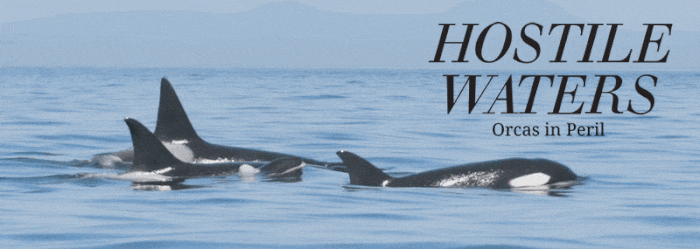PENN COVE, Whidbey Island – Lyla Snover can still hear the cries from the day the captors came for the southern resident orca whales at Penn Cove, in August 1970, separating families as they took their pick for aquariums all over the world.
“It was agony, sadness, screaming, they felt the same way you would feel if someone kidnapped your children, and put them in a pen and you didn’t know where they were,” Snover said at a commemoration of the capture, at which more than 100 people gathered Friday evening at a Coupeville city park overlooking the cove.
Of all the southern residents taken during a series of captures beginning in the 1960s and ending in 1976, in which more than a third of the orcas that frequent Puget Sound were taken, all are dead today but one: Lolita, still performing in captivity at the Miami Seaquarium. The Lummi Nation has for two years campaigned to retire her and bring her home.
Tribal carvers made a totem pole in her honor, and took it all the way to the Miami Seaquarium to protest her captivity. They trailered the totem, carved from a single cedar log, back home this month. All the way to the Penn Cove commemoration, where tribal leaders again recommitted to their quest to bring Lolita home.
The tribe’s vision is to retire her to a netted-off cove, where she would be fed and cared for, and perhaps once again hear the voices of her relations.
Freddie Lane, a Lummi Tribal Council member announced at the ceremony that she also has a new name: “Sk’aliCh’elh-+tenaut” — her Indian name, for the ancestral Indian village that used to be at Penn Cove.
Memories of the capture are still strong in the community today. Perhaps among the whales, too: They have rarely been seen in Penn Cove since the capture era.
John Carpenter said he was only 5 when he and his sister saw a commotion on the ferry that August day — something he would never forget: an orca whale in a crate, covered with wet towels, on the way to Seattle for shipment. Even though he was just a small child, he said he can still remember looking into the orca’s eyes and hearing it breathe, Carpenter said. “It was a terrible, terrible thing.”
And yet seeing orcas in captivity was part of what transformed people’s understanding; Orcas until then were reviled as vicious predators and often shot on sight. Namu, the first orca captured and put on public display in Seattle by orca catcher Ted Griffin, changed people’s minds around the world about orcas forever.
Gary Armstrong of Whidbey Island said he remembers watching Namu’s floating cage go under the Deception Pass bridge on the way to Seattle. “At that time nobody thought too much about captive orcas or what would happen to them, we didn’t realize then, or have the awareness we have toward orcas now.”
Because orcas are highly social, with deep family bonds and keen intelligence, Lolita’s life alone in a tank with no family is highly unnatural. Southern resident orcas in the wild stay together for life in multigenerational family groups. They swim about 50 miles a day and dive hundreds of feet after prey.
Lolita weighs more than 7,000 pounds and is 20 feet long and lives in the smallest tank of any orca in North America – 20 feet at its deepest. The furthest she can swim in a straight line is 60 feet, according to court documents.
She has no one to talk with. Hugo, a male orca with whom she shared the tank, died in 1980. The two Pacific white-sided dolphins she lives with today bite and harass her, according to depositions. She spends much of her time staring at the wall of her tank, according to court documents. One expert observer described her in a deposition as “almost catatonic” – when not performing for her food twice daily for paying customers.
Eric Eimstad, general manager of the Miami Seaquarium, said in a statement emailed to The Seattle Times that Lolita is better off at the Miami Sequarium than in her home waters where the southern residents battle extinction,
“Miami Seaquarium would like to reiterate our respect for the people of the Lummi Nation and applaud their recent efforts to bring attention to the challenges facing the critically endangered killer whale population in the Pacific Northwest,” Eimstad said in the statement.
“There is no room for debate on what is best for Lolita … For almost 5 decades we have provided and cared for Lolita, and we will not allow her life to be treated as an experiment. We will not jeopardize her health by considering any move from her home here in Miami.”
The National Oceanic and Atmospheric Administration would have to approve any move of Lolita, who is estimated to be 54 years old and has spent nearly her entire life in captivity. Multiple legal challenges intended to free her have not succeeded, and more court action is pending.
The tribe won’t ever give up on bringing her back home, Lane said. “We still have hope.”
Howard Garrett of the nonprofit Orca Network, has visited Lolita at the Seaquarium and like others (including the late Gov. Mike Lowry) also has also worked on efforts to free her, stretching back decades. He said he can’t believe she is still alive.
“How does she do it, how does she face each day, all day, all night in total isolation, to live within these same lifeless white walls.”

The opinions expressed in reader comments are those of the author only and do not reflect the opinions of The Seattle Times.